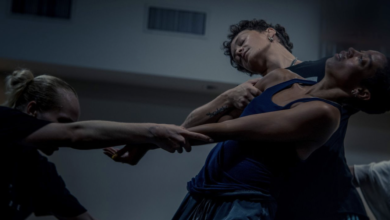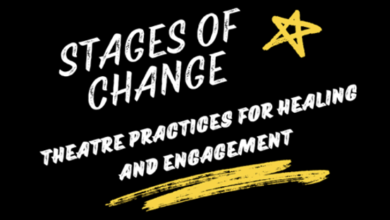
Once the children are seated, the conductor welcomes them and asks a few questions that they answer freely. For many of them, this is their first time attending a theatrical performance. Next, each member of the company introduces themselves and shares an emotion they are feeling at this moment or have felt recently. We do brief representations of these emotions and in this way, we model how the children will participate.
The theatrical performance begins. It is a dramatized reading where the conductor reads from a large book while the actors and music interpret the scenes. The three tales we adapted belong to the Mapuche, Aonikenk, and Atacameño traditions, and they have very different themes and rhythms which, through humor and connection with nature, allow us to open a dialogue around issues such as friendship, death, and trust.
The story is represented up to a climactic point where suddenly a page of the book has been “lost.” The play stops completely as we search for the lost page, and the room fills with murmurs and bewilderment: this must be the worst theatre company in the world! The conductor then asks the audience what can be done to solve the situation. Invariably, the children propose the solution they are experts in: to create!
We go on to create an ending together, but first we want to talk about what we saw in the play. At this moment, the conductor asks the audience to reflect on the internal world of the characters: What do they think the grandmother felt when she was left alone? How do they think the girl felt when the condor deceived her? It is heartbreaking to see that the more under resourced the school, the more limited the emotional language of the children. They usually start by saying that the character felt “bad” or “good.” Guided by the conductor, they move on to identifying simple emotions, such as “sad” or “scared,” and rarely to more complex ones such as “confused” or “hopeful.” We then ask the audience when they had felt that way. We often encounter difficult stories, sometimes related to family violence, bullying, loneliness, or mourning. Managing these narratives properly and representing them in symbolic ways that avoid re-traumatization was part of the consistent training our theatre team received from our director.
At this point, the emotions and stories shared by the children are represented by the actors and actresses in an improvised manner using the Playback Theatre methodology. We create “sculptures,” brief representations that highlight some important aspects of what was narrated.
After three of these representations, we move on to creating endings. The conductor gathers ideas through specific questions. It is important to accept all ideas without criticizing. We do not seek a logical development in the narrative, but rather for the children to see their imagination validated.





